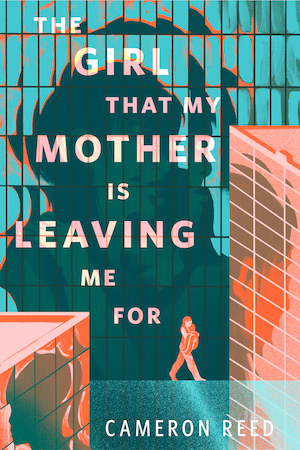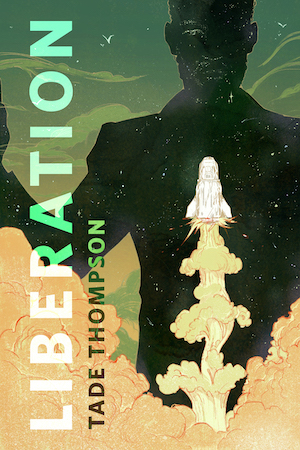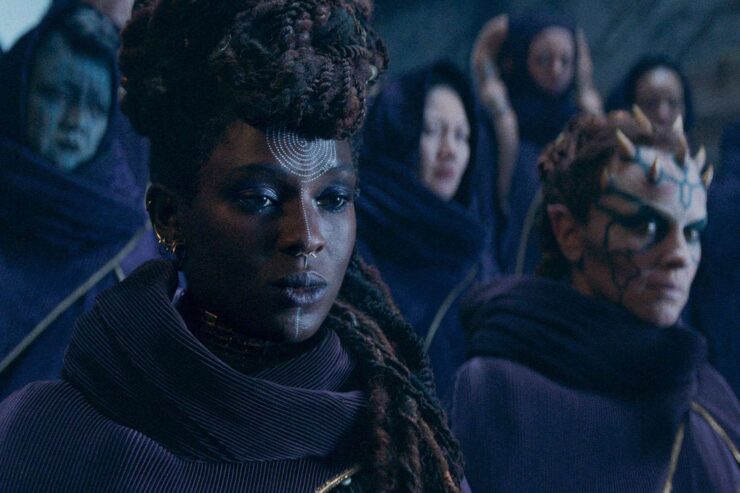Welcome to Close Reads! Leah Schnelbach and guest authors will dig into the tiny, weird moments of pop culture—from books to theme songs to viral internet hits—that have burrowed into our minds, found rent-stabilized apartments, started community gardens, and refused to be forced out by corporate interests.
I love witches. I love them in any iteration, in any universe, and in every way. The thread found in most stories of witches tends to be that they are women at the fringe of their culture practicing an art, be it healing or midwifery or potions or spells or fortune telling, that is seen as “mysterious”. That mystery typically translates to “dangerous”—and ends with pitchfork mobs and burning stakes. Sometimes a healing potion is just a healing potion, but sometimes a healing potion is a poison meant for an abusive husband. (Honestly, that is only dangerous if you are the abusive husband type, but the fear turns to suspicion that then takes hold in very real ways.)
And while it’s long been held in most stories that a woman with magical powers is automatically coded as a witch by audiences, the idea that they are somehow dangerous, underhanded, untrustworthy at times also made its way to the arc of storytelling. From Galadriel in Lord of the Rings to Melisandre in Game of Thrones to Elphaba in Wicked, we never truly know or trust what these women could do with their powers. They could do something if they can do anything! Avert your eyes and hide the children!
Part of me wants to decry how unfair that is to women, while another part wants to say that’s how it should be. Maybe women should be feared for what they could do—and who am I to say what I’d do, had I the power to read minds, keep my gray hairs at bay, or turn people who annoy me to monkeys?
(I mean, maybe be a little scared is all I’m saying. If we aren’t going to be trusted with power, then fine. Fear me. Well, fear me while you admire my many necklace trinkets and witchy boots and would you like an apple, my dear?)
My favorite world by far is that of the Star Wars universe, so obviously I have a very high affinity for the witches in that galaxy. Witches, specifically the Nightsisters, have long been seen from the Jedi’s perspective: women who use the force in ways that are different from what is sanctioned by the peacekeeping Jedi. They are evil, full stop.
And, well, some of them are baddies. Revenge is a dish best served as a force choke, after all. But some of the Jedi are bad, too, so no one can safely throw kyber crystals from Coruscant balconies, ok?
(It would mess up space traffic for DAYS; just don’t do it, trust me.)
The Nightsisters appear in The Clone Wars film, with the formidable Ventress going sabre to sabre with Yoda and later Obi-Wan and Anakin in the animated series. Their banter is a whole vibe with sarcastic quips flying faster than you can jump to hypserspace. One battle on Teth, Ventress tells Kenobi that he’s late and to “never keep a lady waiting.” In Obi-Wan’s typical dry manner, he replies that he was simply looking for Anakin, who must have stood her up. “Consider me on the rebound,” she declares, their frenemy status firmly set.
As we move through the series, more about the Nightsisters come to light: their planet, Dathomir, has long been strong in the force, they dominate the men who they test to make Sith (hello Darth Maul), and they are dangerous and deadly when it comes to the force. Ventress grapples with her ties to her home, her sisters and family, but also the dark side; the leader of the clan, Mother Talzin, has her own arc later in the Clone Wars series where she sets about to drain the power from another planet, a genocidal plan Mace Windu thwarts in all his badassery (props to Jar Jar for the assist).
Through it all, though, the Nightsisters, as dark force users aligned with the Sith, color all the audience knows about witches in the galaxy.
While the witches in The Acolyte are not the Nightsisters, various types of witches clearly occupy the galaxy as Indara initially seeks to respect their practices and culture, a solid fistbump of sister solidarity. (And if Obi-Wan taught us anything, it’s that from a certain point of view, things can look murky.) The story of the force, however, has largely been told through the lens of the Jedi: only Jedi are sanctioned to force wield, only Jedi determine who is trained in the force, only Jedi decide how and in what ways the force may be used, only Jedi can take children away from their families and train them to be deadly weapons.
What is generally left out of these passive voice declarations is that these directives are self-appointed.
The Acolyte expands on what some Jedi-suspicious Star Wars fans have long thought: that the Jedi are a cult with strict and repressive practices, leading us and Senator Rayencourt to ask “who made you boss?” The show gives us a different and more measured view of witches than we saw in The Clone Wars’ handling of the Nightsisters (who, well, really did love making Siths).
Indara clearly outlines that they will not involve themselves in the coven, even if Sol felt they were too cult-like (insert irony here). He claims they have weird rituals! a weird temple! can move things with their minds! are super secretive about what they do and oh no, only we can do that! Jedi Trinity doesn’t know or even care to know, which means we also don’t know; the witches were living, laughing, and loving their best lives, and Indara had no reason or desire to interfere. Being a Jedi gave him and Torbin an inflated sense of importance. They saw the Jedi as arbiters not just of peace, but of freedom, justice, and security. It’s that entitlement (and boredom from Torbin) that fuels them into bullying the coven to do what they wanted, but no matter the perspective here, all the dead bodies were witches, not Jedi.
And what of these witches?
They were keenly aware of the Jedi’s feelings about them, their practice, and even their existence. They stayed hidden for a reason with some hints that they were forced into hiding. Indara is either an outlier or magnanimous or both, but The Acolyte showed them as people; not fully power hungry, not inherently evil, and certainly not deserving of death when Jedi show up at their home with questions they already know the answers to (yes, these children are force sensitive; no, you cannot take them; yes, we will get mad and fight you if you try). Sol’s late justification that his theory about them was correct, that they were the result or cause of a Vergence, still fails to align with his actions 16 years ago on Brendok. And Venestra’s revision of the cover-up, blaming Sol in order to protect the Order, failed to soften the idea that witches were dangerous.
Because, really, who cares if the witches were up to no good? I mean, not me, honestly. (I contradict myself? Very well, I contradict myself.) They made twins from the force. Ok. Someone with a brief cameo in The Acolyte likely made Anakin, after all. The Jedi had no problems using Clones, bred and grown to champion their cause. And I, a red lightsaber lover, am certainly not saying that witches need to be good. Far from it, in fact. It’s delightful when they are bad because bad usually means they act counter to the ways a woman should act—they are weary of insipid men, use sarcasm like a well-sharpened dagger, and dress for ease of comfort rather than the male gaze. I do think the trope that they are always bad is tiresome, though, and they aren’t bad merely because they are shunned. Or because they are women. Or because they have power. Or because they were scorned. Mostly because they are people and sometimes people are just bad and need revenge or like causing chaos or do it for the plot.
At the end of the day, though, is there anywhere a witch can go to safely practice throwing the force, eat spice creams, and chant in unison under the moons without some dry-cleaned Jedi with a fancy laser sword showing up? Is that really too much to ask?











There is also Charal from the TV movie The Battle for Endor. Though there are probably some who would like to believe that production never happened.
Galaxies are big places, and there is certainly room there is certainly room in the Star Wars galaxy for all sorts of witches and magical folks. One thing I like about the High Republic books is that they show all sorts of groups who view and tap into the Force in different ways.
I have always like Asajj Ventress, and her sassy attitude. I liked seeing her again in Bad Batch, and would love to see the next Star Wars animated series including her further adventures.
I too would enjoy more witches in Star Wars. My favorite Clone Wars episodes involved the Night Sisters. I am hoping for season two of both The Acolyte and Ahsoka especially featuring more strong, Force and weapon wielding witchy women. Even if we don’t get on screen versions maybe we will get some comics or novels with more of their stories.
I just want some new stories, with new force users. Witches would be great!
Shouldn’t the Force be capitalized…?